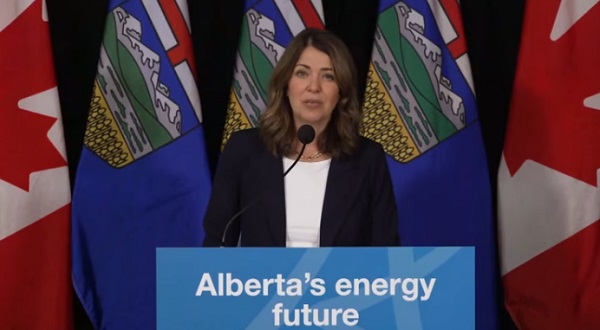Business
Cost of federal government debt rising for Canadians

From the Fraser Institute
As the federal deficit persists and government debt mounts, the burden of debt interest costs is growing for Canadian taxpayers.
The Trudeau government is on track for another large budget deficit forecasted at $40.0 billion, slightly larger than the $35.3 billion deficit last year. The government’s long-term forecast suggests deficits will continue throughout the projection period, which ends in 2028/29.
There’s nothing new about the federal books being splashed with red ink. The Trudeau government has run significant deficits every year of its tenure. What’s different this time, however, is that due to higher interest rates the cost of the government’s borrowing is much higher. As a result, debt costs are set to increase significantly in the years ahead, which will burden taxpayers today and in the future while also making it harder for future prime ministers and finance ministers to balance their books.
Let’s dig a bit deeper into the numbers. When the Trudeau government took power during fiscal year 2015/16, debt interest costs were $21.8 billion. In 2021/22, despite a long string of deficits and huge increase in debt, low interest rates during the period of intensive borrowing prevented a surge in debt interest costs, which stood at $24.5 billion.
But last fiscal year marked the start of a new chapter in Canada’s fiscal history as higher interest rates combined with significant debt accumulation caused debt interest costs to rise substantially, from $24.5 billion to $35.0 billion. Another similar increase is expected this year, with debt costs forecasted to rise to $46.5 billion—a 90 per cent increase in just two years with a further projected increase to $52.4 billion for next year.
This sudden increase in debt interest costs has important and immediate implications for federal finances. In 2021/22, 5.9 per cent of all federal revenue was spent on paying the interest on federal debt. By next year, according to Trudeau government forecasts, this will rise to 10.8 per cent.
Canadian history shows us how debt interest costs can quickly spiral out of control. During the debt crisis of the early 1990s, after many years of continuous deficits, debt interest costs were consuming one-third of every dollar Ottawa collected. Today’s debt interest costs are not as high as they were in the 1990s, but there’s no reason to wait until a crisis develops to take action.
The fact that debt interest is taking a bigger bite out of federal revenue should not just be a matter of academic concern for public finance economists. It affects all Canadian taxpayers. A larger share of the money collected from individuals and businesses being spent on debt leaves less for other priorities such as tax relief, which can help encourage economic growth, or core public services that Canadians value.
The Trudeau government has often spoken about the benefits of fiscal restraint but has thus far failed to exercise much of it. If the prime minister and his cabinet want to halt the growth in debt interest they must reverse the free spending that has characterized their time in government to slow the accumulation of debt.
Authors:
Alberta
Falling resource revenue fuels Alberta government’s red ink

From the Fraser Institute
By Tegan Hill
According to this week’s fiscal update, amid falling oil prices, the Alberta government will run a projected $6.4 billion budget deficit in 2025/26—higher than the $5.2 billion deficit projected earlier this year and a massive swing from the $8.3 billion surplus recorded in 2024/25.
Overall, that’s a $14.8 billion deterioration in Alberta’s budgetary balance year over year. Resource revenue, including oil and gas royalties, comprises 44.5 per cent of that decline, falling by a projected $6.6 billion.
Albertans shouldn’t be surprised—the good times never last forever. It’s all part of the boom-and-bust cycle where the Alberta government enjoys budget surpluses when resource revenue is high, but inevitably falls back into deficits when resource revenue declines. Indeed, if resource revenue was at the same level as last year, Alberta’s budget would be balanced.
Instead, the Alberta government will return to a period of debt accumulation with projected net debt (total debt minus financial assets) reaching $42.0 billion this fiscal year. That comes with real costs for Albertans in the form of high debt interest payments ($3.0 billion) and potentially higher taxes in the future. That’s why Albertans need a new path forward. The key? Saving during good times to prepare for the bad.
The Smith government has made some strides in this direction by saving a share of budget surpluses, recorded over the last few years, in the Heritage Fund (Alberta’s long-term savings fund). But long-term savings is different than a designated rainy-day account to deal with short-term volatility.
Here’s how it’d work. The provincial government should determine a stable amount of resource revenue to be included in the budget annually. Any resource revenue above that amount would be automatically deposited in the rainy-day account to be withdrawn to support the budget (i.e. maintain that stable amount) in years when resource revenue falls below that set amount.
It wouldn’t be Alberta’s first rainy-day account. Back in 2003, the province established the Alberta Sustainability Fund (ASF), which was intended to operate this way. Unfortunately, it was based in statutory law, which meant the Alberta government could unilaterally change the rules governing the fund. Consequently, by 2007 nearly all resource revenue was used for annual spending. The rainy-day account was eventually drained and eliminated entirely in 2013. This time, the government should make the fund’s rules constitutional, which would make them much more difficult to change or ignore in the future.
According to this week’s fiscal update, the Alberta government’s resource revenue rollercoaster has turned from boom to bust. A rainy-day account would improve predictability and stability in the future by mitigating the impact of volatile resource revenue on the budget.
Business
Higher carbon taxes in pipeline MOU are a bad deal for taxpayers

The Canadian Taxpayers Federation is criticizing the Memorandum of Understanding between the federal and Alberta governments for including higher carbon taxes.
“Hidden carbon taxes will make it harder for Canadian businesses to compete and will push Canadian entrepreneurs to shift production south of the border,” said Franco Terrazzano, CTF Federal Director. “Politicians should not be forcing carbon taxes on Canadians with the hope that maybe one day we will get a major project built.
“Politicians should be scrapping all carbon taxes.”
The federal and Alberta governments released a memorandum of understanding. It includes an agreement that the industrial carbon tax “will ramp up to a minimum effective credit price of $130/tonne.”
“It means more than a six times increase in the industrial price on carbon,” Prime Minister Mark Carney said while speaking to the press today.
Carney previously said that by “changing the carbon tax … We are making the large companies pay for everybody.”
A Leger poll shows 70 per cent of Canadians believe businesses pass most or some of the cost of the industrial carbon tax on to consumers. Meanwhile, just nine per cent believe businesses pay most of the cost.
“It doesn’t matter what politicians label their carbon taxes, all carbon taxes make life more expensive and don’t work,” Terrazzano said. “Carbon taxes on refineries make gas more expensive, carbon taxes on utilities make home heating more expensive and carbon taxes on fertilizer plants increase costs for farmers and that makes groceries more expensive.
“The hidden carbon tax on business is the worst of all worlds: Higher prices and fewer Canadian jobs.”
-

 Alberta11 hours ago
Alberta11 hours agoFrom Underdog to Top Broodmare
-

 armed forces2 days ago
armed forces2 days ago2025 Federal Budget: Veterans Are Bleeding for This Budget
-

 Alberta1 day ago
Alberta1 day agoAlberta and Ottawa ink landmark energy agreement
-

 Artificial Intelligence2 days ago
Artificial Intelligence2 days agoTrump’s New AI Focused ‘Manhattan Project’ Adds Pressure To Grid
-

 International2 days ago
International2 days agoAfghan Ex–CIA Partner Accused in D.C. National Guard Ambush
-

 Carbon Tax2 days ago
Carbon Tax2 days agoCanadian energy policies undermine a century of North American integration
-

 International2 days ago
International2 days agoIdentities of wounded Guardsmen, each newly sworn in
-

 International2 days ago
International2 days agoTrump Admin Pulls Plug On Afghan Immigration Following National Guard Shooting









